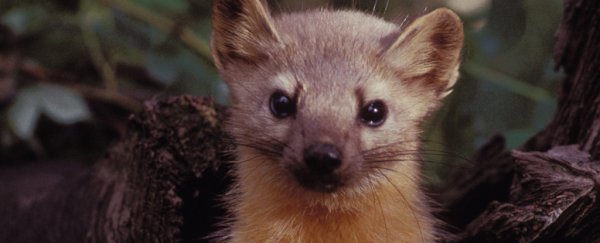The broad legalisation of marijuana in California might be a big win for trade, tax, and lovers of a toke, but it could be a serious threat to one bushy-tailed little predator.
Populations of Humboldt martens (Martes americana humboldtensis) have already been struck down thanks to years of shrinking habitat. But it's taken the proliferation of marijuana farms for the California Department of Fish and Wildlife to finally take steps to have them listed as endangered.
We're hesitant to appeal to an animal's cuteness to draw attention to its plight. There are plenty of less exciting organisms that also need our attention.
Tierra Curry from Portland's Center for Biological Diversity has the perfect description for this fuzzball of squee.
"It's a kitten that thinks it's a honey badger," Curry told Maria Finn from The Guardian.
"It will crawl right into a bee nest and eat the honeycomb and larvae, getting its face stung the whole time."
Honeycomb might be a favourite dessert, but the animal's main diet consists of small animals like rodents and lizards. And that diet is putting it in harm's way.
It's surprising that the cat-sized carnivore isn't on the endangered list already. Before 1996, people assumed this subspecies of the slightly more common American marten had already gone extinct.
Right now they're listed as a California Species of Special Concern. Such a listing has no real legal weight, serving only as an advertisement for animals at risk.
With maybe a hundred or so believed to be slinking through Northern California's forests – and a small population clinging to dear life in Oregon – it's still shockingly close to vanishing in the wild.
There have been previous efforts to encourage the government to act. Groups like the Center for Biological Diversity and the Environmental Protection and Information Center (EPIC) have been trying to get action on the matter for years.
Now the State of California has issued a report detailing the plight of the Humboldt marten, serving as a basis for a recommendation to the California Fish and Game Commission to get it listed as endangered.
So what's changed? It's hard to say for sure, but the surge in cannabis crops – both legal and illicit – has introduced a new potential threat just might be more than the marten can bear.
Clearing land for the crops is just the start of their woes. To keep rodents from chewing on plastic irrigation tubing and being a general nuisance, farmers are turning to a heavy duty anticoagulant in the form of a bait.
Rats and mice eat the rodenticide, in turn becoming a deadly snack for predators like the Humboldt marten.
Sound familiar? Only a few months ago the very same problem was linked with the dead bodies of two species of endangered owl.
These are just the ones that have made headlines. According to EPIC, the California Department of Fish and Wildlife has a record on more than 350 such incidents of wildlife poisonings.
Unlike the owls, there's no hard evidence that the martens are dropping thanks to the bait. But with numbers so small and the fact the martens eat the same food as the owls, the risks are just too great to ignore.
Cannabis can now be owned and grown in California, providing opportunity for economic growth and freeing police resources to focus on things other than pot.
Following changes to state law, adults can apply for a license to cultivate cannabis crops.
That doesn't mean everybody follows the rules; by some estimates, fewer than one in a hundred growers have a license. With literally thousands of cultivation sites popping up across the state, all of this makes for a challenging problem to solve.
A happier headline might have been 'California set to ban gut-bleeding rodenticides in the face of wildlife risks'.
But right now we'll take what we can get, and keep our fingers crossed something happens soon.
